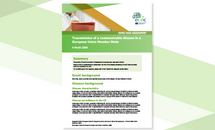Rapid risk assessment: Ebola virus disease outbreak in North Kivu and Ituri Provinces, Democratic Republic of the Congo – fourth update
This is the fourth update of a rapid risk assessment originally produced on 9 August 2018. This rapid risk assessment addresses the public health risk associated with the current Ebola virus outbreak in the DRC and its implications for EU/EEA citizens. It was triggered by an increase of EVD transmission in the affected areas over recent weeks, the persistent occurrence of new cases among contacts unknown at the time of EVD diagnosis, the occurrence of a substantial number of cases outside of the ring vaccination contacts and current challenges for the prevention and control of EVD.
Executive Summary
As of 10 April 2019, the Ministry of Health of the Democratic Republic of the Congo has reported 1 206 Ebola virus disease (EVD) cases, including 1 140 confirmed and 66 probable cases, resulting in an overall case fatality of 63%. Eighty-seven healthcare workers are among the confirmed cases, including 31 deaths.
Since mid-March, the weekly number of cases has increased to more than 50, ranging from 52–73 cases. Viral circulation in the community is persistent, but the epidemiological situation varies among affected health zones. While the majority of the cases have been reported in urban settings, there are cases in rural health zones surrounding urban centres, suggesting transmission ongoing in these areas.
Despite the impressive mobilisation of EVD response actors, significant challenges remain in this complex setting, marked by a long-term humanitarian crisis and an unstable security context. Community resistance to Ebola response activities, suboptimal infection prevention and control practices in primary healthcare, incomplete contact tracing and follow-up, continuing nosocomial infections, delays in detection and isolation of new cases and community deaths leading to potential exposure of relatives to EVD continue to be among the main obstacles.
More EVD cases are expected in the coming weeks and a wider geographical extension is still possible given the prolonged humanitarian crisis in the region. Important cross-border population flows to and from neighbouring provinces and countries and adverse impact of security incidents and persistence of community reluctance and resistance that hinders the implementation of EVD prevention and control measures.
The probability that EU/EEA citizens living or travelling in EVD-affected areas of the DRC will be exposed to the virus is low provided they adhere to recommended precautionary measures.
The most likely route of importation of the virus into the EU/EEA is through infected travellers from affected areas. Since the volume of travellers is small, there are no international airports in the affected areas with direct flights to EU/EEA Member States and exit screening is in place at Goma airport, the risk of EVD-infected people arriving in the EU/EEA is very low. However, the risk can only be eliminated by stopping transmission at local level.





